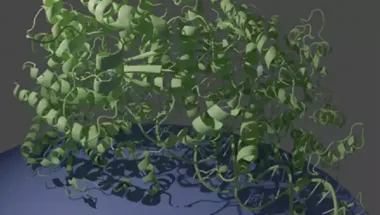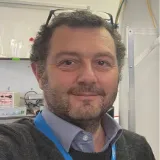The Centre brings together advanced instrumentation in NMR and a number of other biophysical techniques to provide a set of facilities to promote the study of biological molecules, from proteins to metabolites, both in basic and medical science, and for projects that translate these advances into clinical understanding and benefit. It provides expertise and state-of-the-art biophysical facilities to King's research groups and external users.
The Centre for Biomolecular Spectroscopy was established in 2010 with a Capital Award from the Wellcome Trust and the support of the School of Biomedical Sciences.
The Centre for Biomolecular Spectroscopy is a contemporary laboratory for the investigation of protein structure, dynamics and interactions, as well as analysis of metabolites and mixtures, and structural elucidation of small molecules.
Structural Biology
The CSB NMR Facility is home to state-of-the-art equipment for investigating the structure and dynamics of proteins. We offer users two high field instruments at 700 and 800MHz dedicated and optimised for structural biology applications. These are equipped with helium cooled cyroprobes for optimal sensitivity. We offer users a full suite of modern experiments for protein assignment, structure determination, and relaxation and dynamics studies. Our 700MHz instrument has a 4-channel QCI-P cryoprobe with a 31P channel that allows users to extend the scope of their structural biology projects to include nucleic acids.
Metabolomics
The CBS NMR Facility provides users with access to advanced equipment for NMR metabolomics studies. Our 600MHz and 700MHz NMR instruments are equipped with cryogenically cooled probes, offering excellent sensitivity for studies of various biofluids, and aqueous and lipid cell extracts. Both also have SampleJet automated sample changers that accept up to 5 racks of 96 3mm or 5mm NMR tubes for automated medium-throughput analysis of large numbers of samples. We also offer users access to our SamplePro liquid handling robot, allowing for the efficient and automated preparation of large numbers of NMR samples for analysis. The 600MHz NMR also has a HR-MAS probe available for metabolic analysis of intact tissues.
Biomolecular Interactions
The CSB provides users with a range of equipment for characterising biomolecular interactions that complement the structural biology capabilities of the centre, to provide a comprehensive range of techniques for protein biophysics. We provide three isothermal titration calorimetry (iTC) instruments which deliver direct, label free, in-solution measurements of binding affinity and thermodynamic parameters in a single experiment. These include the Malvern Panalytical Microcal PEAQ, the gold standard for measuring affinity and stoichiometry, as well as the Automated Microcal PEAQ for increased throughput and efficiency.
Furthermore, CSB users have access to the Biacore T100 instrument for surface plasmon resonance (SPR). This can be used to investigate a wide variety of molecular interactions where one binding partner can be immobilised on a chip, providing information on specificity, affinity and kinetics of biomolecular interactions.
Optical Spectroscopy
The CBS Optical Spectroscopy facility provides users with a research facility for the measurement and interpretation of chiroptical (optical activity) data. Applied Photophysics Ltd. Chirascan and Chirascan Plus instruments, conceived in collaboration with Dr. Alex F. Drake, are multimode spectrometers capable of measuring absorption, fluorescence and light scattering properties for ordinary, linearly and circularly polarised light over the 170-1200 nm region. Applications include the assignment of absolute stereochemistry, the analysis of biopolymer conformation, quality control of biologicals, the study of molecular interactions and 1 ms stopped-flow kinetics.
Facility staff
Affiliated academics
The Centre for Biomolecular Spectroscopy provides a suite of biophysical instruments for investigating the structure and function of biomolecules and the properties of biomolecular interactions. Equipment in the Centre for Biomolecular Spectroscopy includes NMR spectrometers, CD spectrophotometers, and instrumentation for ITC and SPR.
Related equipment

400 MHz NMR Spectrometer
Equipped with Avance NEO console

600 MHz NMR Spectrometer
Equipped with Avance NEO console 1H,13C,15N TCI prodigy nitrogen-cooled cryoprobe 1H, 13C HR-MAS probe SampleJet sample changer (5x96 tubes)

700 MHz NMR Spectrometer
Equipped with an Avance III console, 1H/13C/15N/31P QCI helium-cooled cryoprobe, BBO probe for multinuclear versatility, and a SampleJet

800 MHz NMR Spectrometer
Equipped with Avance NEO console 1H,13C,15N TCI helium-cooled cryoprobe

Surface Plasmon Resonance (Biacore)
A versatile biophysical tool for characterising molecular interactions and enabling real-time and label-free binding studies.

Bruker SamplePro Tube
The SamplePro Tube is a XYZ robotic system for general liquid handling tasks to support sample preparation.

Optical Spectroscopy
Multimode spectrometers, measuring absorption, fluorescence and light scattering properties for ordinary, linearly and circularly polarised light (170-1200 nm)

Isothermal Titration Calorimetry
A single ITC experiment allows the determination of binding affinities and stoichiometries, and the thermodynamic parameters (ΔH, ΔS) of an interaction.
2021 Publications
Rees, M., Nikoopour, R., Fukuzawa, A. et al. (2021) Making sense of missense variants in TTN-related congenital myopathies. Acta Neuropathol 141, 431–453.
Ali, S., Dussouillez, C., Padilla, B., Frisch, B., Mason, J. & Kichler, A. (2021) Design of a new cell penetrating peptide for DNA, siRNA and mRNA delivery J Gene Med. 24(e3401)
Yingshan Qiu, Maria Clarke, Leon Wan, Jason Lo, James Mason, Jenny K. W. Lam. (2021) Optimization of PEGylated KL4 Peptide for siRNA Delivery with Improved Pulmonary Tolerance. Molecular Pharmaceutics 18(6)
Reg Rehal, Robert D. Barker, Zidong Lu, Tam T. Bui, Bruno Demé, Gerd Hause, Christian Wölk, Richard D. Harvey. (2021) Lipid domain formation and non-lamellar structures associated with varied lysylphosphatidylglycerol analogue content in a model Staphylococcal plasma membrane. BBA – Biomembranes 1863(5)
C. Pollard, M. Hudson, J.M. McDonnell, P.G. Royall and K. Wolff. (2021) Development of a point-of-care test for the detection of MDMA in latent fingerprints using surface plasmon resonance and lateral flow technology Drug Test Anal 14(4)
V.F. Ilkow, A.M. Davies, B. Dhahliwal, A.J. Beavil, B.J. Sutton and J.M. McDonnell. (2021) Reviving lost binding sites: Exploring calcium-binding site transitions between human and murine CD23. FEBS Open Bio, 11:1827-1840
The Centre for Biomolecular Spectroscopy is a contemporary laboratory for the investigation of protein structure, dynamics and interactions, as well as analysis of metabolites and mixtures, and structural elucidation of small molecules.
Structural Biology
The CSB NMR Facility is home to state-of-the-art equipment for investigating the structure and dynamics of proteins. We offer users two high field instruments at 700 and 800MHz dedicated and optimised for structural biology applications. These are equipped with helium cooled cyroprobes for optimal sensitivity. We offer users a full suite of modern experiments for protein assignment, structure determination, and relaxation and dynamics studies. Our 700MHz instrument has a 4-channel QCI-P cryoprobe with a 31P channel that allows users to extend the scope of their structural biology projects to include nucleic acids.
Metabolomics
The CBS NMR Facility provides users with access to advanced equipment for NMR metabolomics studies. Our 600MHz and 700MHz NMR instruments are equipped with cryogenically cooled probes, offering excellent sensitivity for studies of various biofluids, and aqueous and lipid cell extracts. Both also have SampleJet automated sample changers that accept up to 5 racks of 96 3mm or 5mm NMR tubes for automated medium-throughput analysis of large numbers of samples. We also offer users access to our SamplePro liquid handling robot, allowing for the efficient and automated preparation of large numbers of NMR samples for analysis. The 600MHz NMR also has a HR-MAS probe available for metabolic analysis of intact tissues.
Biomolecular Interactions
The CSB provides users with a range of equipment for characterising biomolecular interactions that complement the structural biology capabilities of the centre, to provide a comprehensive range of techniques for protein biophysics. We provide three isothermal titration calorimetry (iTC) instruments which deliver direct, label free, in-solution measurements of binding affinity and thermodynamic parameters in a single experiment. These include the Malvern Panalytical Microcal PEAQ, the gold standard for measuring affinity and stoichiometry, as well as the Automated Microcal PEAQ for increased throughput and efficiency.
Furthermore, CSB users have access to the Biacore T100 instrument for surface plasmon resonance (SPR). This can be used to investigate a wide variety of molecular interactions where one binding partner can be immobilised on a chip, providing information on specificity, affinity and kinetics of biomolecular interactions.
Optical Spectroscopy
The CBS Optical Spectroscopy facility provides users with a research facility for the measurement and interpretation of chiroptical (optical activity) data. Applied Photophysics Ltd. Chirascan and Chirascan Plus instruments, conceived in collaboration with Dr. Alex F. Drake, are multimode spectrometers capable of measuring absorption, fluorescence and light scattering properties for ordinary, linearly and circularly polarised light over the 170-1200 nm region. Applications include the assignment of absolute stereochemistry, the analysis of biopolymer conformation, quality control of biologicals, the study of molecular interactions and 1 ms stopped-flow kinetics.
Facility staff
Affiliated academics
The Centre for Biomolecular Spectroscopy provides a suite of biophysical instruments for investigating the structure and function of biomolecules and the properties of biomolecular interactions. Equipment in the Centre for Biomolecular Spectroscopy includes NMR spectrometers, CD spectrophotometers, and instrumentation for ITC and SPR.
Related equipment

400 MHz NMR Spectrometer
Equipped with Avance NEO console

600 MHz NMR Spectrometer
Equipped with Avance NEO console 1H,13C,15N TCI prodigy nitrogen-cooled cryoprobe 1H, 13C HR-MAS probe SampleJet sample changer (5x96 tubes)

700 MHz NMR Spectrometer
Equipped with an Avance III console, 1H/13C/15N/31P QCI helium-cooled cryoprobe, BBO probe for multinuclear versatility, and a SampleJet

800 MHz NMR Spectrometer
Equipped with Avance NEO console 1H,13C,15N TCI helium-cooled cryoprobe

Surface Plasmon Resonance (Biacore)
A versatile biophysical tool for characterising molecular interactions and enabling real-time and label-free binding studies.

Bruker SamplePro Tube
The SamplePro Tube is a XYZ robotic system for general liquid handling tasks to support sample preparation.

Optical Spectroscopy
Multimode spectrometers, measuring absorption, fluorescence and light scattering properties for ordinary, linearly and circularly polarised light (170-1200 nm)

Isothermal Titration Calorimetry
A single ITC experiment allows the determination of binding affinities and stoichiometries, and the thermodynamic parameters (ΔH, ΔS) of an interaction.
2021 Publications
Rees, M., Nikoopour, R., Fukuzawa, A. et al. (2021) Making sense of missense variants in TTN-related congenital myopathies. Acta Neuropathol 141, 431–453.
Ali, S., Dussouillez, C., Padilla, B., Frisch, B., Mason, J. & Kichler, A. (2021) Design of a new cell penetrating peptide for DNA, siRNA and mRNA delivery J Gene Med. 24(e3401)
Yingshan Qiu, Maria Clarke, Leon Wan, Jason Lo, James Mason, Jenny K. W. Lam. (2021) Optimization of PEGylated KL4 Peptide for siRNA Delivery with Improved Pulmonary Tolerance. Molecular Pharmaceutics 18(6)
Reg Rehal, Robert D. Barker, Zidong Lu, Tam T. Bui, Bruno Demé, Gerd Hause, Christian Wölk, Richard D. Harvey. (2021) Lipid domain formation and non-lamellar structures associated with varied lysylphosphatidylglycerol analogue content in a model Staphylococcal plasma membrane. BBA – Biomembranes 1863(5)
C. Pollard, M. Hudson, J.M. McDonnell, P.G. Royall and K. Wolff. (2021) Development of a point-of-care test for the detection of MDMA in latent fingerprints using surface plasmon resonance and lateral flow technology Drug Test Anal 14(4)
V.F. Ilkow, A.M. Davies, B. Dhahliwal, A.J. Beavil, B.J. Sutton and J.M. McDonnell. (2021) Reviving lost binding sites: Exploring calcium-binding site transitions between human and murine CD23. FEBS Open Bio, 11:1827-1840














